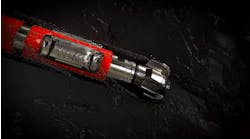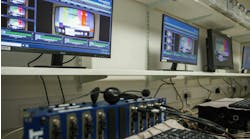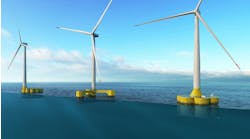FINLAND: Water injection, catalytic reduction cut NOx emissions on Wartsila engines
Wärtsilä has been working on a new developments to provide environ-mentally sound options on power generation. The new "Enviroengine" range includes a common rail system for smokeless engines, direct water injection to reduce nitrogen oxide and nitrous oxide (NOx) emissions, and a combined silencer and SCR (selective catalytic reduction) unit for overall emissions control.
The smokeless engine concept tackles the particularly sensitive issue of eliminating visible smoke by using state-of-the-art common rail injection technology that comprises a pressurizing pump and a fuel accumulator for every two cylinders. By splitting up the fuel volumes in several accumulators, the risk of pressure waves in the common rail is avoided. This has the added safety advantage of limiting high-pressure fuel to the hot box of the engine and is economic as it uses the existing camshaft to drive the valves.
Wärtsilä has already introduced the Common Rail system for its medium-speed and low-speed engines. The Wärtsilä 46 and Wärtsilä 32 engines are available for delivery this year with the Wärtsilä 38 and Sulzer ZA40 engines scheduled for pilot delivery soon after. The company expects retrofit packages for some of its older engines will also be available. For users, the advantages are:
- Lower fuel consumption
- Lower NOx and the possibility of using different NOx ratings
- No visible smoke at any load
- Ability to start the engine without visible smoke
- Load cycling without smoke
- Interchangeable cylinder specific components
- Lower maintenance costs.
Direct water injection
To reduce NOx emissions further, Wärtsilä has introduced water injection directly into the combustion chamber of its new engine range. The key is a valve through which the water and fuel are injected, typically in a water-to-fuel ratio of 0.4-0.7. According to Wärtsilä, typical emission reductions of 50-60% are achievable without affecting the power output or engine components.
Engines fitted with direct water injection are equipped with a combined injection valve and nozzle allowing injection of water and fuel into the cylinder. The nozzle has two separate needles that are also controlled separately. This means that neither of the modes - water on or off - will affect the operation of the engine. The water injection takes place before fuel injection, resulting in a cooler combustion space and therefore lower NOx emissions. Water injection also stops before injection of the fuel oil into the cylinder so that ignition and combustion processes are not disturbed.
Water is fed to the cylinder head at high pressure, 210-400 bar, depending on the engine type. High water pressure is generated in a high-pressure water pump module. A low-pressure pump is also necessary to ensure a sufficiently stable water flow to the high-pressure pump. Before entering the low-pressure pump, the water needs to be filtrated to remove all solid particles. The pumps and filters are built into modules for easy installation.
The system requires minimum space, making it applicable for retrofitting at low investment costs, and built-in safety features enable immediate water shut-off in the event of excessive water flow or water leakage without affecting engine operation.
Catalytic reduction
Another development designed to reduce emissions is the Compact SCR, which Wärtsilä believes is currently the most efficient method of reducing NOx. In this system, a reducing agent, such as an aqueous solution of urea, is injected into the exhaust gas at a temperature of 290-450° C. The urea in the exhaust gas decays into ammonia which is then put through a catalysing process that converts the NOx into harmless nitrogen and water. The SCR method could reduce NOx emissions by 85-99% to achieve NOx levels of 2g/kWh or lower.
A typical SCR plant consists of a reactor that contains several catalyst layers, a dosing and storage system for the reagent, and a control system. The SCR reactor is a square steel container large enough to house the layers of catalytic elements.
The rate of NOx reduction depends on the amount of urea injected and the reduction rate can be increased by a corresponding increase in the catalyst volume.
Transocean upgrade
In its more traditional market sector, Wärtsilä has been selected to provide power generation for a Transocean SedcoForex semisubmersible. The latter has taken receipt of four Wärtsilä generating sets for re-powering the 135D semi being upgraded from a drilling rig to a de-watering production unit.
A significant part of the upgrade is a completely new power generation package consisting of four Wärtsilä 12V200 diesel engines rated at 2,020 kW each. The engines, which were delivered to a fast-track schedule, are designed to have superior transit loading performance, which was important since a large portion of the electrical load is represented by the crude oil export pumps.
The 135D unit will separate water from crude oil and export produced oil through a pipeline ashore. The project, which is being undertaken at the FELS-Setal shipyard in Angra, Brazil, is a joint venture between Transocean and Schlumberger. When complete, the unit will be under charter to Petrobras until May 2009 operating offshore Brazil in 600 ft of water.


